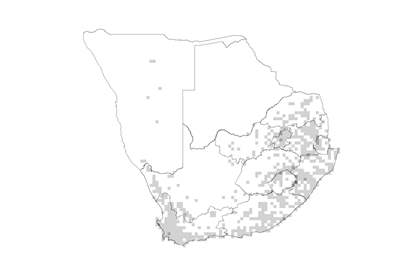 Species distribution and density. Darker squares represent higher density of members of this family. |
Introduction
Star lily family
The family is relatively small with six of its nine genera occurring in southern Africa. In this region, Hypoxis is by far the largest genus. The species are usually among the first to flower and the bright yellow star-like flowers are always a delight to see in a burnt veld after the winter. They flower for quite a long period and contribute to flower displays throughout the season.
Distribution
Although the family is widespread in South America, Australia and tropical Asia, it is most diverse in southern Africa where 5 of the 6 genera are endemic. Locally it occurs in Namaqualand and Western Cape as well as in the eastern part of the country; usually associated with grassland and often with moist or seasonally moist areas.
Number of genera in the world
9
Number of species in the world
130
Number of genera in the Flora of southern Africa region
6
Number of species in the Flora of southern Africa region
87
Well-known southern African genera
Empodium, Hypoxis, Rhodohypoxis, Spiloxene
Growth forms
Herbs with tuberous rhizomes or corms.
Habitats
Rocky habitats, open grassland, often around water or moist areas.
Flagship species
Hypoxis hemerocallidea (African potato; sterblom [A]; inkomfe [Z]) is quite common in the eastern part of the country and is often found in large stands. The leaves and bright yellow star-shaped flowers make this a very attractive plant. Leaves are long, strap-shaped, slightly hairy and deeply v-shaped in cross section. Leaves grow in three directions from a large tuberous corm, which give a characteristic triangular appearance to the plants. The tubers are used in African traditional medicine to treat various ailments and were recently recognised for their immune-boosting and anti-inflammatory properties. They contain sterols and sterolins.
Significance of the family
Tablets, capsules, creams or infusions of Hypoxis hemerocallidea (also marketed under the older name, H. rooperii) are commercially available. This species has traditionally been used to treat many ailments related to diabetes, blood loss, endometriosis, PMS, arthritis, cancer and viral infections. Several Hypoxis species will make very attractive garden plants, but it is Rhodohypoxis baurii and R. milloides, which are most widely cultivated. These are miniature plants with pink or white star-flowers. Rhodohypoxis baurii and its cultivars are popular container plants in Europe, Japan, Australia and New Zealand.
Diagnostic characters
Geophytes with a vertical tuberous rhizomes or corms . Leaves basal, arranged in 3 ranks , with parallel longitudinal grooves, sometimes pleated; old leaf bases fibrous . Flowers regular , borne on leafless stalks; perianth in 2 whorls of 3 tepals each, yellow, white or pink , greenish on the outside and persistently hairy. Stamens 6, in 2 whorls of 3 each, rising from base of flower on short filaments . Ovary inferior; style short.
Did you know?
Several Hypoxis species contain toxic substances in the unprocessed or raw form.